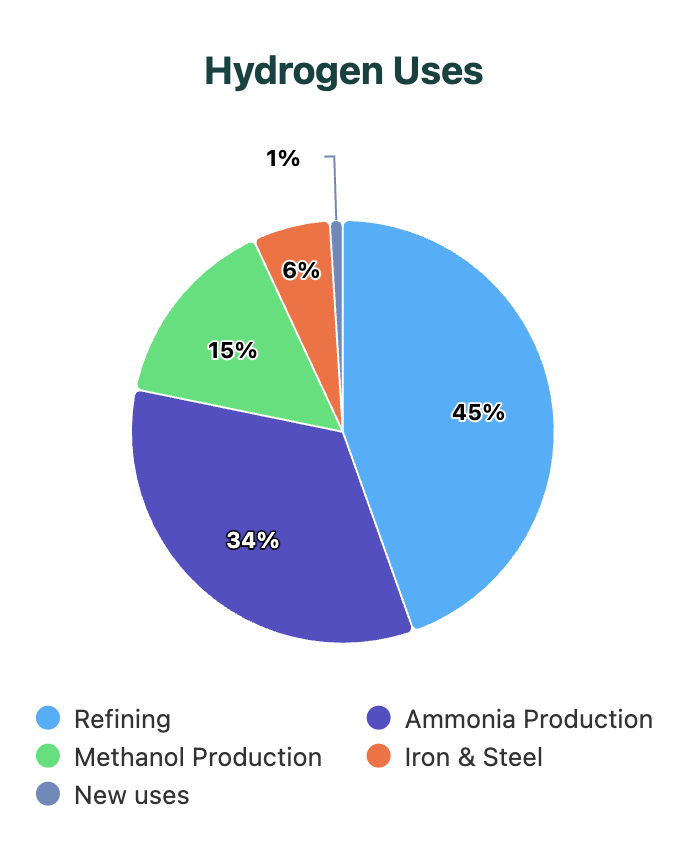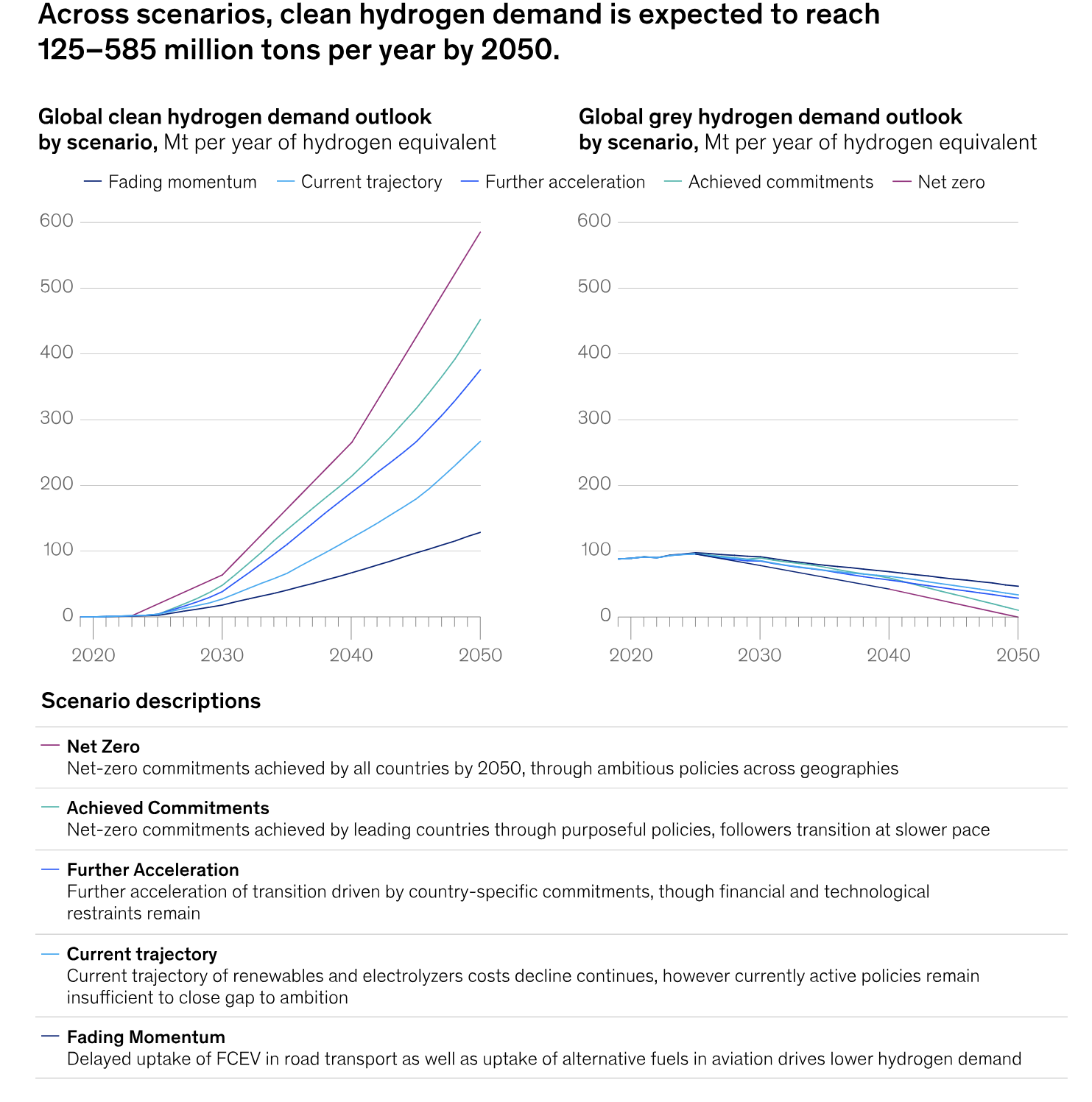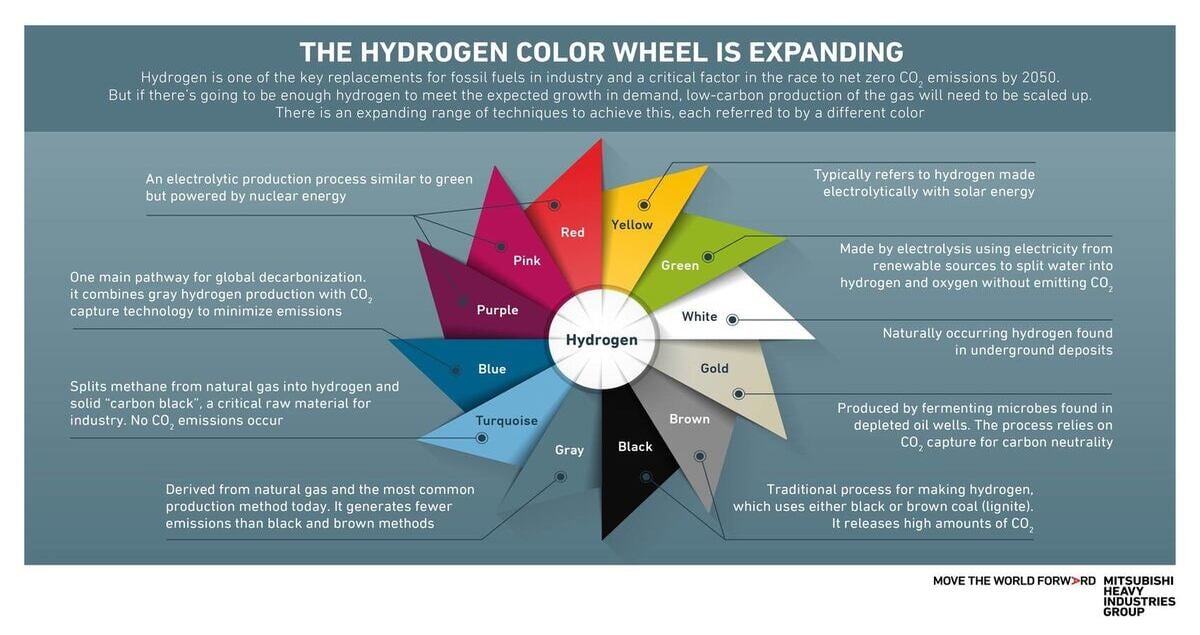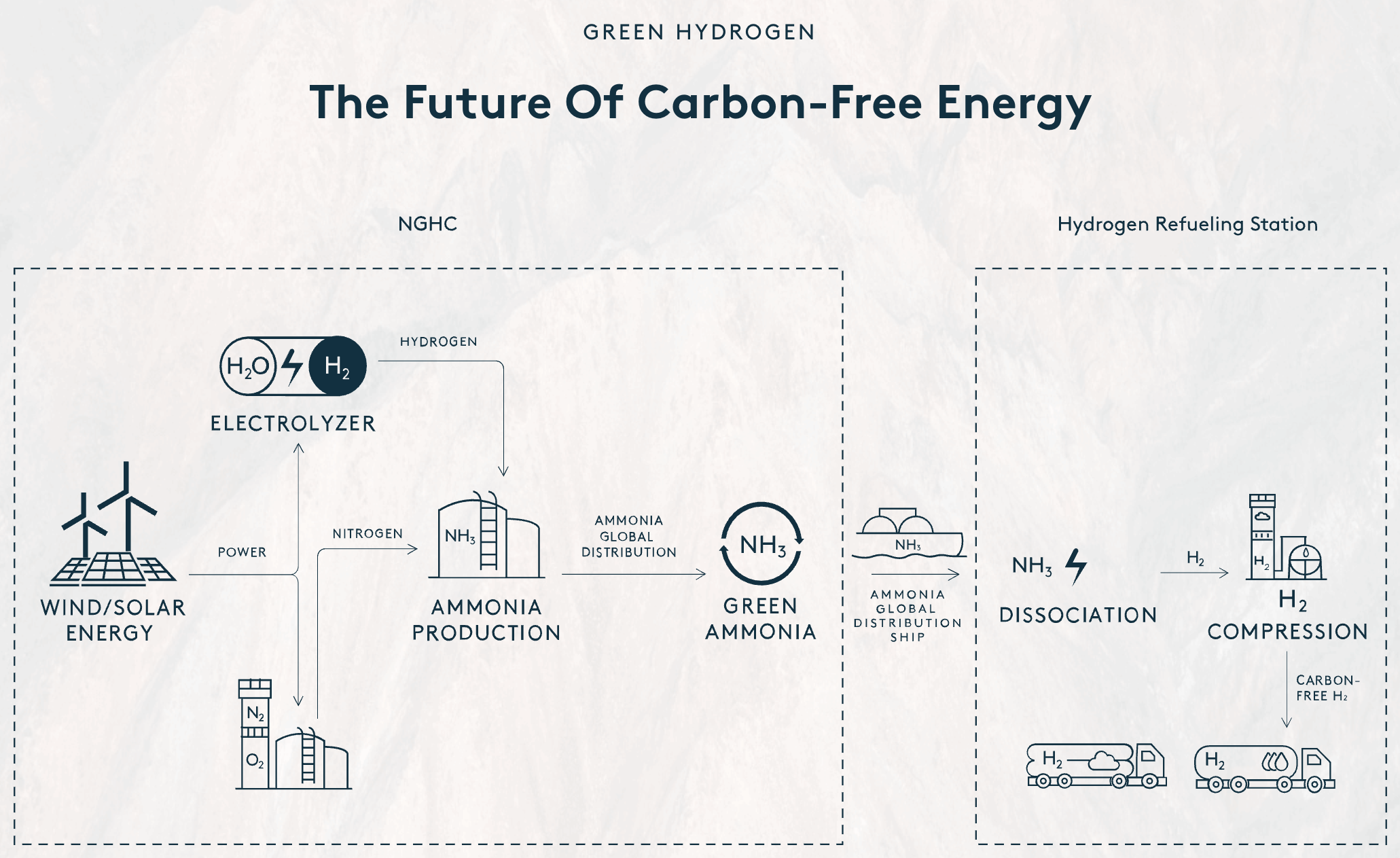Insights - May 28, 2025
An Analysis on Hydrogen Colours And Their Sustainability Potential


Written by Solar Impulse Foundation 7 min read
Hydrogen; the Future of Sustainability?
Last year, our founder Bertrand Piccard announced the launch of his groundbreaking and innovative upcoming mission: Climate Impulse. After going around the Earth with the Solar Impulse Aiplane between 2015-2016, Bertrand Piccard aims to push the boundaries of pioneering even further by flying a green hydrogen-powered airplane around the globe without layovers in less than 10 days. In 2028, this project will showcase the feasibility of green aviation and demonstrate hydrogen’s potential to propel our world into an era of environmental sustainability and energy efficiency.

Public Engagement and Strategic Debate:
A transition to hydrogen still implies challenges and is a theme of serious discussions in academic and industry circles. A recent debate held at the Geneva School of Business and attended by members of the Solar Impulse Foundation explored the potential of hydrogen in aviation.
Through a SWOT( Strengths, Weaknesses, Opportunities and Threats) analysis, students were able to highlight the potential of hydrogen to support our climate goals and to be a scalable alternative to traditional fuels. It is still costly as there currently is a lack of skilled labor and production infrastructure to support widespread adoption. In addition, the energy required for transportation and storage is high. However, bringing to light hydrogen’s potential as a direct zero-carbon emitter, noise pollution reducer and scalable alternative to fossil fuels in order to gain public and investor support might help it to gain early adoption.
These discussions reinforce the need for balanced, well-supported strategies but first and above all, greater public awareness about hydrogen and its various forms.1
Hydrogen on Earth
To understand why hydrogen is central to our society and to a sustainable future, we must explore its fundamental role:
0.00005% of the Atmosphere’s volume in the form of gas (H2).2
Hydrogen atoms constitute approximately 11% of water’s total mass.3
10% of our body mass.4
Additionally, hydrogen has an immense impact on our everyday lives: according to an IEA report, more than 90 million tonnes of hydrogen are produced globally each year only for industrial purposes (ammonia production, oil refining, methanol production). Here are a few interesting figures to illustrate the distribution of hydrogen consumption on Earth:
95% for Industrial applications: fertiliser manufacturing via the Haber-Bosch process, desulfurisation, and hydrocracking to produce cleaner fuels, feedstock for plastics, solvents, and synthetic fuels.
1% for energy/ fuel: hydrogen fuel cells, backup power, energy storage.
0.01% for aerospace/ spaceflight: rocket propulsion (liquid hydrogen for NASA space missions).
4% for emerging uses like clean transports (trucks, buses, trains) or hydrogen blending in gas grids.
 An Insight on The Global Hydrogen Demand in 2023 By Stanford University
An Insight on The Global Hydrogen Demand in 2023 By Stanford UniversityHow Will it Evolve?
The demand for hydrogen is estimated to continue rising but especially to diversify in the coming years:
50-60% for Industrial Applications: further production of ammonia, methanol and steel, growth in low-carbon processes.
15-20% for Transport: fuel cell vehicles development (especially shipping and heavy-duty transport).
20-25% for Power Generation & Storage: electricity generation, grid balancing, long-term energy storage.
5-10% Building & Heating: growth of residential and commercial heating applications.
These numbers from McKinsey & Company’s 2023 Global Energy Perspective further illustrate the importance of hydrogen in creating a cleaner world. However, not every type of hydrogen can be used as a sustainable source of energy or fuel, there is a clear distinction to be made between the different types and colours of hydrogen.
 Hydrogen Demand Predictions from McKinsey & Company's 2023 Global Energy Perspective
Hydrogen Demand Predictions from McKinsey & Company's 2023 Global Energy Perspective
Carbon-Emitting Hydrogen Colours
Black or brown hydrogen is produced by coal gasification, a process that generates significant CO2 emissions (19 tCO2/tH2).5 It is used to synthesise ammonia, especially in China and India which are coal-rich countries that use ammonia as a source of fertilizer or in South Africa to convert coal to liquid fuels.
Grey hydrogen is a product of fossil fuels through steam gas reforming or coal gasification. Grey hydrogen is the world’s primary hydrogen solution today; it represents 95%6 of our society’s hydrogen consumption and is used for hydrogenation processes in food or electronics, or to produce methanol globally. Presently, it is the most attractive hydrogen option financially as it costs around $1-$2 per kilogram of H2.7 However, it is not a viable option as it releases 10-19 tons of CO2 per ton of H2 into the atmosphere.8
Obtained from natural gas by steam gas reforming paired with carbon capture and sequestration (CCS), blue hydrogen is seen as a “bridge technology” on the path to full decarbonisation. It significantly reduces CO2 emissions (1-4 tCO2/tH2)9 compared to grey hydrogen and remains relatively cheap ($2.20-$4.50 per kilogram of H2).10 Blue hydrogen is increasingly being implemented into the transport industry as a power source for heavy trucks, buses, trains, and ships.
 The Hydrogen Colour Wheel
The Hydrogen Colour WheelPromising and Technologically Accessible Hydrogen Colours
Green hydrogen originates from renewable energy sources like wind or solar through a process known as water electrolysis, where an electrolyser splits water molecules into oxygen. This process generates between 0-2.5kg CO2 per kg H2,11 depending on the source of electricity and efficiency of the electrolysis process, making it the cleanest form of hydrogen we have nowadays. Currently, the costs of green hydrogen are high ($3-$8 per kilogram H2),12 which can explain why it accounts for less than 0.1% of the world’s hydrogen production.13 To change that, green hydrogen production facilities need to be developed. In Saudi Arabia, the NEOM project aims to build the world’s largest green hydrogen plant. Only by expanding these structures can the production of green hydrogen become accessible on a global scale.
Yellow hydrogen is also developed using water electrolysis and uses electricity from the general power grid, which is typically a mix of fossil fuels, renewables, and nuclear. As power grids modernise, yellow hydrogen could become the cheapest form of renewable hydrogen in the medium term. Sweden is a great example to follow: approximately 99% of its energy mix is based on clean sources as of 2024.
Purple, pink, and red hydrogen can also be seen as clean energy sources, as they do not emit CO2 during their production. Like green hydrogen, they are products of water electrolysis but powered by nuclear power and heat instead of renewable energy sources. This means that they are zero-carbon emitters if the nuclear source is emissions-free. These hydrogen colours are currently easier to access than green hydrogen, as the production facilities (nuclear plants) are more frequent. However, the price of production can vary significantly from one region to another depending on the political and public acceptance of nuclear plants.
 NEOM's Green Hydrogen Production Explained
NEOM's Green Hydrogen Production Explained
Potentially Clean Hydrogen Colours in Early Development Stages
Orange Hydrogen targets the production of hydrogen out of plastic waste through pyrolysis, microwave catalysis and photo-reforming. These technical and chemical processes decompose plastic waste in the absence of oxygen using microwave energy and light-activated catalysts. The target is to extract hydrogen from plastic material to turn waste into a valuable energy source. This complex technology still requires fine-tuning and isn’t mature at industrial scale yet. Plastic varies a lot in its composition (polyethylene vs. PVC) making it difficult to extract enough hydrogen. Catalysts are an essential part to the production process but are currently very expensive, prone to errors and not optimised for large-scale production.
Turquoise Hydrogen is hydrogen produced from natural gas following a methane pyrolysis. Natural gas is decomposed into hydrogen and solid carbon at high temperatures. Because the carbon is solid, it isn’t released in the atmosphere but needs to be stored, which can cause additional logistical strains. Maintaining the high temperatures required for the production process is challenging and currently energy-intensive, as well as being expensive. Because this hydrogen still requires methane in its production phase, the supply chain leaks can undermine climate benefits. Turquoise hydrogen might need some time before proving itself as a clean solution, but could well become an alternative.
An insight into the production of turquoise hydrogen:
A
What to Remember
An energy’s sustainable potential vastly depends on the production process that leads to its existence. Electric Vehicles are undeniably a way to reduce our greenhouse gas emissions, as they directly release far less carbon than cars running on natural gases. However, in order to have a definitive and positive impact on the environment, solutions to reduce our carbon footprint in the production process need further development. If the source of electric power or the batteries remain fossil fuels or other carbon-emitting materials in the long term, we are only hiding and delaying our problems, not finding solutions.
This same principle applies for the further development of hydrogen technologies. In 2023, the International Energy Agency (IEA) estimated that only 1% (!) of the global hydrogen production could be considered as clean. By 2030, projections from McKinsey claim that this number could rise to 30%. An important expansion of clean hydrogen-producing technologies will be vitally important if green hydrogen is to become a globally affordable option.
Thankfully, the technologies to develop clean hydrogen production already exist! The Solar Impulse Foundation has been monitoring and labelling innovative technologies like Ways2H’s Hydrogen Solution, where waste streams are converted into clean hydrogen without incineration. This thermochemical process produces syngas and leaves pure carbon, char, as a byproduct. The char is then collected and used as a fuel together with the remaining tail-gas to generate sufficient energy for the thermochemical conversion of the waste feedstock. This technology has been adopted by the UK to convert waste to fuel and serve as many as 1,600 fuel cell buses per day. By providing 500kg to 1 ton of renewable hydrogen fuel per day to heavy-duty trucks, lorries, or other Heavy Goods Vehicles, these vehicles will be able to cover 11,000 road kilometres!
The development of existing technologies in addition to the emergence of alternative solutions could also open new employment opportunities for workers forced to transit from the fossil fuel or oil industry to the field of clean energies, whether it be an operational or construction job for an electrolytic hydrogen facility. The UK government projects that its hydrogen strategy could lead to the creation of 64,000 jobs and generate over £7 billion in gross value added annually by the end of the decade.
 ZeroAvia's Hydrogen-Powered Airplane, The First Zero-Emission Commercial Passenger Flight Between Rotterdam and London
ZeroAvia's Hydrogen-Powered Airplane, The First Zero-Emission Commercial Passenger Flight Between Rotterdam and London
Final Word
Stating that a technology has potential is one thing, but it is only by backing these words with concrete actions that important stakeholders can be convinced to invest in a transition to hydrogen solutions. Projects like Ways2H’s Hydrogen Solution or Climate Impulse could play a key role in proving to the world that hydrogen might be a path full of new opportunities from both an environmental-friendly and financial-improving perspective.
Pioneers are always the first to launch themselves on an adventure, but their acts aim to show that what was thought impossible at first can be achieved and reproduced on a larger scale!

References:
HEG-Ge Debate:
1. The informations from this section are bases on the SWOT analysis done by the students of the Geneva School of Business, for more informations:
https://gbsge.com/about-us/vision-and-mission
Hydrogen on Earth:
2. https://en.wikipedia.org/wiki/Hydrogen
3. https://www.doubtnut.com/qna/643051824
4. https://www.livescience.com/common-elements-in-human-body
Hydrogen Colours Figures:
5,6,8,9. https://www.belfercenter.org/research-analysis/colors-hydrogen
7. https://hydrogen-central.com/green-hydrogen-costs-set-to-stay-too-high-for-too-long
10. https://energiesmedia.com/why-investing-in-hydrogen-could-be-your-smartest-move-in-2025
11. https://pubs.rsc.org/en/content/articlelanding/2023/ya/d3ya00318c
12. https://artinenergy.com/is-green-hydrogen-profitable
13. https://www.iea.org/energy-system/low-emission-fuels/hydrogen

Written by Solar Impulse Foundation on May 28, 2025












